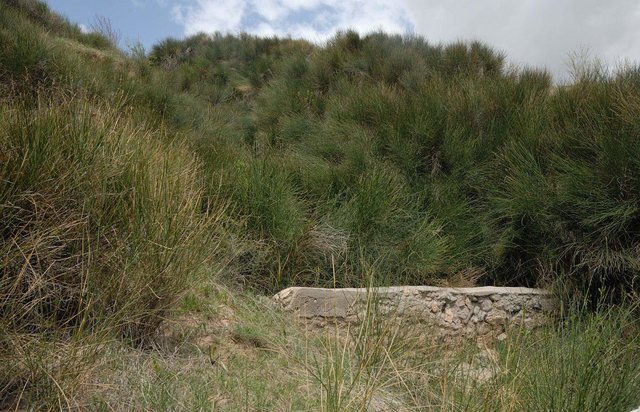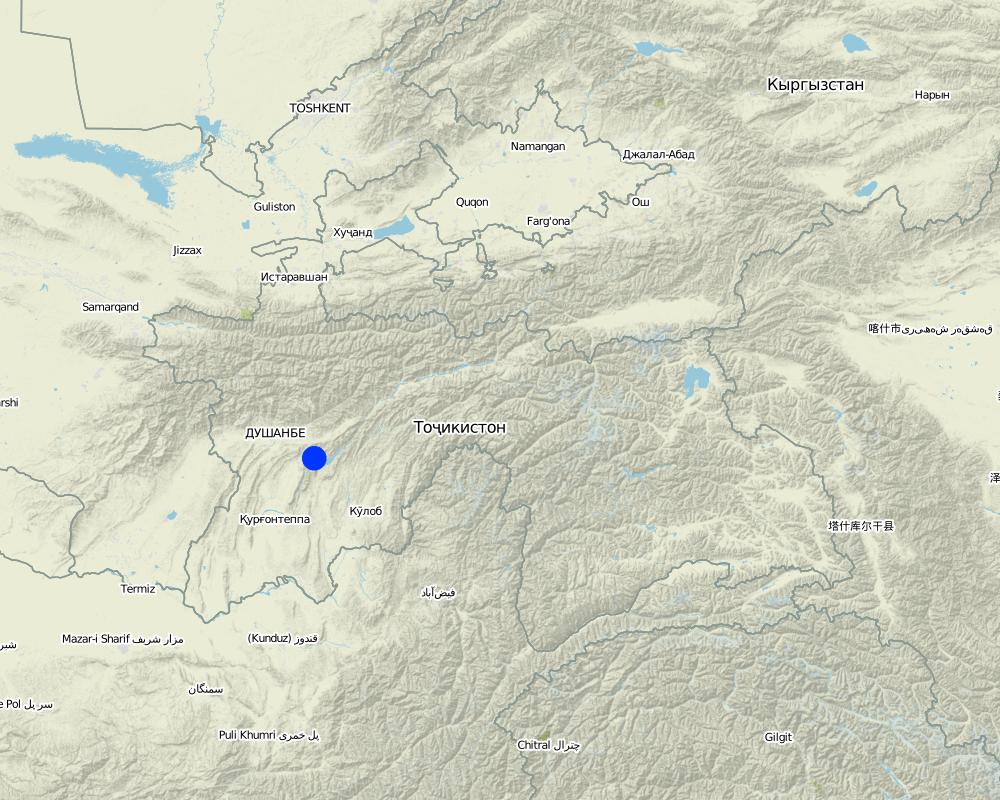Field research station for analysing soil conservation measures [ทาจิกิสถาน]
- ผู้สร้างสรรค์:
- การอัพเดท:
- ผู้รวบรวม: Gulniso Nekushoeva
- ผู้เรียบเรียง: –
- ผู้ตรวจสอบ: David Streiff
approaches_2573 - ทาจิกิสถาน
ดูส่วนย่อย
ขยายทั้งหมด ย่อทั้งหมด1. ข้อมูลทั่วไป
1.2 รายละเอียดที่ติดต่อได้ของผู้รวบรวมและองค์กรที่เกี่ยวข้องในการประเมินและการจัดเตรียมทำเอกสารของแนวทาง
ผู้เชี่ยวชาญ SLM:
ผู้เชี่ยวชาญ SLM:
ชื่อของโครงการซึ่งอำนวยความสะดวกในการทำเอกสารหรือการประเมินแนวทาง (ถ้าเกี่ยวข้อง)
Tajik Soil Insitute (Tajik Soil Institute) - ทาจิกิสถานชื่อของโครงการซึ่งอำนวยความสะดวกในการทำเอกสารหรือการประเมินแนวทาง (ถ้าเกี่ยวข้อง)
CDE Centre for Development and Environment (CDE Centre for Development and Environment) - สวิตเซอร์แลนด์1.3 เงื่อนไขที่เกี่ยวข้องกับการใช้ข้อมูลที่ได้บันทึกไว้ผ่านทาง WOCAT
ผู้รวบรวมและวิทยากรหลักยอมรับเงื่อนไขเกี่ยวกับการใช้ข้อมูลที่ถูกบันทึกผ่านทาง WOCAT:
ใช่
1.4 การอ้างอิงถึงแบบสอบถามเรื่องเทคโนโลยี SLM

Gully rehabilitation [ทาจิกิสถาน]
Gullies are stabilized through the establishment of a gabion and the plantation of spanish drok (Spartium junceum L).
- ผู้รวบรวม: Qobiljon Shokirov
2. คำอธิบายของแนวทาง SLM
2.1 การอธิบายแบบสั้น ๆ ของแนวทาง
Research Station of the Tajik Academy of Agrarian Science, Soil Institute conducting research on soil conservation and productivity in the rainfed hill zones of central Tajikistan.
2.2 การอธิบายอย่างละเอียดของแนวทาง
การอธิบายอย่างละเอียดของแนวทาง:
Aims / objectives: The main goal of the research station is the rehabilitation and protection of erosion prone loess areas through monitoring of soil erosion and soil moisture, gully rehabilitation, rehabilitation of degraded pastures through the establishment of a vineyard on terraced land.
Methods: Researchers and students of the department of soil erosion together with the field station manager and several laboratory assistants are conducting field experiments for their research e.g. standardised runoff plots. The demonstration plots are also used in teaching of university students and for project visits.
Stages of implementation: The research station was established in 1968.
Role of stakeholders: The land belonging to the field station was rented out to a group of 5 farmers who are directed by the researchers and have to deliver 50% of the crop yield to the soil institute.
Other important information: During the last years the research station has received additional support from international organisations and programmes such as ICARDA, IAEA-FAO and NCCR North-South for renovating infrastructure (buildings, climate station etc.).
2.5 ประเทศ ภูมิภาค หรือสถานที่ตั้งที่ได้นำแนวทางไปใช้
ประเทศ:
ทาจิกิสถาน
ภูมิภาค/รัฐ/จังหวัด: :
RRS
ข้อมูลเฉพาะเพิ่มเติมของสถานที่ตั้ง:
Faizabad, Javonon, Karsang
Map
×2.6 วันที่เริ่มต้นและสิ้นสุดของแนวทาง
ระบุปีที่เริ่ม:
1968
2.7 ประเภทของแนวทาง
- research
2.8 เป้าหมายหรือวัตถุประสงค์หลักของแนวทาง
The Approach focused mainly on SLM with other activities (productivity increase, testing of crop types)
The main goal of the research station is the rehabilitation and protection of erosion prone loess areas through monitoring of soil erosion and soil moisture, gully rehabilitation, rehabilitation of degraded pastures through the establishment of a vineyard on terraced land.
The SLM Approach addressed the following problems: knowledge gaps in agricultural production and soil erosion
2.9 เงื่อนไขที่เอื้ออำนวยหรือเป็นอุปสรรคต่อการนำเทคโนโลยีภายใต้แนวทางนี้ไปปฏิบัติใช้
การมีไว้ให้หรือการเข้าถึงแหล่งการเงินและบริการ
- เป็นอุปสรรค
lack of finances to conduct research
Treatment through the SLM Approach: mobilization of government funding
การจัดตั้งระดับองค์กร
- เป็นอุปสรรค
technical experts were not available
Treatment through the SLM Approach: capacity building of institutional human potential
กรอบแนวทางในการดำเนินการด้านกฎหมาย (การถือครองที่ดิน สิทธิในการใช้ที่ดินและน้ำ)
- เอื้ออำนวย
The existing land ownership, land use rights / water rights greatly helped the approach implementation: state ownership of land facilitated the establishment of the research station
- เป็นอุปสรรค
legal status unclear
Treatment through the SLM Approach: new law that the land of the research station can not be given away as certificate
ความรู้เกี่ยวกับ SLM การเข้าถึงการสนับสนุนด้านเทคนิค
- เป็นอุปสรรค
lack of technical equipment
Treatment through the SLM Approach: provided by government and rented by land users
อื่นๆ
- เป็นอุปสรรค
limited agricultural knowledge
Treatment through the SLM Approach: pilot projects, disseminate knowledge through trainings and seminars
3. การมีส่วนร่วมและบทบาทของผู้มีส่วนได้ส่วนเสียที่เกี่ยวข้อง
3.1 ผู้มีส่วนได้ส่วนเสียที่เกี่ยวข้องในแนวทางนี้และบทบาท
- ผู้ใช้ที่ดินระดับท้องถิ่นหรือชุมชนระดับท้องถิ่น
- ผู้เชี่ยวชาญ SLM หรือที่ปรึกษาการเกษตร
- รัฐบาลระดับท้องถิ่น
- รัฐบาลแห่งชาติ (ผู้วางแผน ผู้ทำการตัดสินใจ)
- Academy of Aicultural Sciences
3.2 การเกี่ยวข้องของผู้ใช้ที่ดินระดับท้องถิ่นหรือชุมชนระดับท้องถิ่นในช่วงต่างๆของแนวทาง
| ความเกี่ยวข้องของผู้ใช้ที่ดินระดับท้องถิ่นหรือชุมชนระดับท้องถิ่น | ระบุผู้ที่มีส่วนเกี่ยวข้องและอธิบายกิจกรรม | |
|---|---|---|
| การริเริ่มหรือการจูงใจ | ไม่มี | |
| การวางแผน | ไม่มี | |
| การดำเนินการ | จ่ายเงินหรือสนับสนุนจากภายนอก | |
| การติดตามตรวจสอบหรือการประเมินผล | ปฏิสัมพันธ์ | |
| Research | ไม่มี |
3.4 การตัดสินใจเลือกใช้เทคโนโลยี SLM
ระบุผู้ที่ทำการตัดสินใจเลือกเทคโนโลยีมากกว่าหนึ่งวิธีไปปฏิบัติใช้:
- ผู้เชี่ยวชาญ SLM เป็นผู้ตัดสินใจหลัก ที่ติดตามให้คำปรึกษากับผู้ใช้ที่ดิน
การอธิบาย:
During Soviet times it was a a top-down government approach to adress knowledge gaps through research. In recent times the farmers have repeatedly taken initiative to tackle problems by writing letters to the institute. IN the end it is the institute that takes the final decisions.
Decisions on the method of implementing the SLM Technology were made by mainly by SLM specialists with consultation of land users
4. การสนับสนุนด้านเทคนิค การสร้างขีดความสามารถ และการจัดการด้านความรู้
4.1 การสร้างขีดความสามารถ / การอบรม
ได้มีการจัดอบรมให้แก่ผู้ใช้ที่ดินหรือผู้มีส่วนได้ส่วนเสียคนอื่น ๆ หรือไม่:
ใช่
ให้ระบุว่าใครเป็นผู้ได้รับการอบรม:
- ผู้ใช้ที่ดิน
- university students
ถ้าเกี่ยวข้อง ให้ระบุ เพศ อายุ สถานภาพ ชาติพันธุ์ เป็นต้น:
land users who are employed at the research station
รูปแบบการอบรม:
- กำลังดำเนินการ
- ใช้พื้นที่ทำการสาธิต
- จัดคอร์ส
หัวข้อที่พูด:
soil erosion, agricultural productivity
4.2 การบริการให้คำแนะนำ
ผู้ใช้ที่ดินมีการเข้าถึงการรับบริการให้คำปรึกษาหรือไม่:
ใช่
การอธิบาย/แสดงความคิดเห็น:
Advisory service is inadequate to ensure the continuation of land conservation activities; lack of finances to conduct new research
4.3 การเสริมความแข็งแกร่งให้กับสถาบัน (การพัฒนาองค์กร)
สถาบันได้รับการจัดตั้งขึ้นมาหรือเสริมความแข็งแกร่งโดยแนวทางนี้หรือไม่:
- ไม่
4.4 การติดตามตรวจสอบและประเมินผล
การติดตามตรวจสอบและประเมินผลเป็นส่วนหนึ่งของแนวทางหรือไม่:
ใช่
ความคิดเห็น:
bio-physical aspects were regular monitored by government through measurements; indicators: soil moisture, soil loss, runoff, soil fertility properties, climate indicators
technical aspects were regular monitored by government through measurements; indicators: different crop rotations
economic / production aspects were regular monitored by government through measurements; indicators: yields
There were several changes in the Technology as a result of monitoring and evaluation: different crop rotation schemes, mulching of vineyards, adaptation of fertilizer amount applied
4.5 การวิจัย
การวิจัยเป็นส่วนหนึ่งของแนวทางหรือไม่:
ใช่
ระบุหัวข้อเรื่อง:
- เทคโนโลยี
ให้ข้อมูลเพิ่มเติมและให้ระบุผู้ทำการวิจัย:
researchers from the soil institute conducting research on soil erosion and agricultural productivity, university students conducting mainly Phd and Postdoc research
Research was carried out on station
5. การสนับสนุนด้านการเงินและวัสดุอุปกรณ์
5.1 ระบุงบประมาณประจำปีสำหรับแนวทาง SLM นี้
แสดงความคิดเห็น (แหล่งของการระดมทุน ผู้บริจาคคนสำคัญ):
Approach costs were met by the following donors: government: 100.0%
5.2 การสนับสนุนด้านการเงิน / วัสดุอุปกรณ์ให้แก่ผู้ใช้ที่ดิน
ผู้ใช้ที่ดินได้รับการสนับสนุนด้านการเงิน / วัสดุอุปกรณ์ไปปฏิบัติใช้เทคโนโลยีหรือไม่:
ใช่
ถ้าใช่ ให้ระบุประเภทของการสนับสนุน เงื่อนไขและผู้จัดหามาให้:
Fully financed by the government through the Academy of Science
5.3 เงินสนับสนุนสำหรับปัจจัยนำเข้า (รวมถึงแรงงาน)
- อุปกรณ์
| ระบุปัจจัยนำเข้าที่ได้รับการสนับสนุน | เห็นด้วยระดับไหน | ระบุเงินสนับสนุน |
|---|---|---|
| เครื่องมือ | ได้รับการช่วยเหลือทางการเงินแบบเต็ม | |
| climate station | ได้รับการช่วยเหลือทางการเงินแบบเต็ม | |
- การเกษตร
| ระบุปัจจัยนำเข้าที่ได้รับการสนับสนุน | เห็นด้วยระดับไหน | ระบุเงินสนับสนุน |
|---|---|---|
| เมล็ด | ได้รับการช่วยเหลือทางการเงินแบบเต็ม | |
| ปุ๋ย | ได้รับการช่วยเหลือทางการเงินแบบเต็ม | |
| seedlings | ||
- วัสดุสำหรับการก่อสร้าง
| ระบุปัจจัยนำเข้าที่ได้รับการสนับสนุน | เห็นด้วยระดับไหน | ระบุเงินสนับสนุน |
|---|---|---|
| หิน | ได้รับการช่วยเหลือทางการเงินแบบเต็ม | |
| ไม้ | ได้รับการช่วยเหลือทางการเงินแบบเต็ม | |
- โครงสร้างพื้นฐาน
| ระบุปัจจัยนำเข้าที่ได้รับการสนับสนุน | เห็นด้วยระดับไหน | ระบุเงินสนับสนุน |
|---|---|---|
| ถนน | ได้รับการช่วยเหลือทางการเงินแบบเต็ม | |
| soil laboratory | ได้รับการช่วยเหลือทางการเงินแบบเต็ม | |
ถ้าแรงงานโดยผู้ใช้ที่ดินเป็นปัจจัยนำเข้าที่มีอยู่มากมาย ระบุด้วยว่าเนื่องจาก:
- ให้ค่าตอบแทนด้วยการสนับสนุนด้านวัสดุอุปกรณ์อื่น ๆ
ความคิดเห็น:
Labour is paid in cash as well
50% of the yield belongs to the land users
5.4 เครดิต
มีการจัดหาเครดิตมาให้ภายใต้แนวทาง SLM หรือไม่:
ไม่ใช่
5.5 แรงจูงใจหรือเครื่องมืออื่น ๆ
แรงจูงใจหรือเครื่องมืออื่น ๆ ได้ถูกนำไปใช้ส่งเสริมการใช้เทคโนโลยี SLM หรือไม่:
ไม่ใช่
6. การวิเคราะห์ผลกระทบและการสรุป
6.1 ผลกระทบของแนวทาง
ช่วยให้ผู้ใช้ที่ดินนำเอาเทคโนโลยี SLMไปใช้และบำรุงรักษาสภาพไว้ได้หรือไม่:
- ไม่ใช่
- ใช่ เล็กน้อย
- ใช่ ปานกลาง
- ใช่ อย่างมาก
During Soviet times recommendations for the land committee were elaborated based on results from the research station, nowadays these mechanisms are not in place anymore and knowledge dissemination to land users is hardly taking place.
ทำให้กลุ่มด้อยโอกาสมีอำนาจทางสังคมและเศรษฐกิจหรือไม่:
- ไม่ใช่
- ใช่ เล็กน้อย
- ใช่ ปานกลาง
- ใช่ อย่างมาก
ปรับปรุงประเด็นของการถือครองที่ดินหรือสิทธิในการใช้ ซึ่งขัดขวางการนำเทคโนโลยีไปใช้ให้ดีขึ้น:
- ไม่ใช่
- ใช่ เล็กน้อย
- ใช่ ปานกลาง
- ใช่ อย่างมาก
before, land was under common use and therefore no conservation activities were implemented
Did the Approach help to alleviate poverty?
- ไม่ใช่
- ใช่ เล็กน้อย
- ใช่ ปานกลาง
- ใช่ อย่างมาก
6.2 แรงจูงใจหลักของผู้ใช้ที่ดินเพื่อที่จะนำ SLM ไปปฏิบัติใช้
- การจ่ายเงินหรือการช่วยเหลือ
- กฎและระเบียบ (ค่าปรับ) หรือการบังคับใช้
top-down enforcement
- เกียรติภูมิ แรงกดดันทางสังคม ความเชื่อมแน่นทางสังคม
6.3 ความยั่งยืนของกิจกรรมของแนวทาง
ผู้ใช้ที่ดินสามารถทำให้สิ่งต่างๆ ที่ได้ปฏิบัติใช้โดยแนวทางนี้ยั่งยืนได้หรือไม่ (โดยไม่มีการสนับสนุนจากภายนอก):
- ใช่
ถ้าตอบว่าใช่ ให้อธิบายว่าอย่างไร :
farmers continue with maintenance activities
6.4 จุดแข็งและข้อได้เปรียบของแนวทาง
| จุดแข็ง / ข้อได้เปรียบของแนวทางในทัศนคติของผู้ใช้ที่ดิน |
|---|
| Access to new technologies for farmers working on the research station (How to sustain/ enhance this strength: ensure ongoing research activities) |
| Capacity building for PhD and Postdoc students |
| จุดแข็ง / ข้อได้เปรียบของแนวทางในทัศนคติของผู้รวบรวมหรือวิทยากรหลัก |
|---|
| Specific knowledge gaps can be adressed with field experiments (How to sustain/ enhance this strength: ensure ongoing financial support for research activities from diverse sources such as government, international organisations or through provision of services) |
| Enables longterm research and monitoring (How to sustain/ enhance this strength: continued government ownership and support) |
6.5 จุดอ่อน / ข้อเสียเปรียบของแนวทางและวิธีในการแก้ไข
| จุดอ่อน / ข้อเสียเปรียบในทัศนคติของผู้รวบรวมหรือวิทยากรหลัก | สามารถแก้ไขปัญหาได้อย่างไร |
|---|---|
| On-station approach might not reflect the situation of local farmers | using the research station as a base for conducting research on land of surrounding villages |
| Nowadays there are no efforts to disseminate the knowledge among local farmers in Tajikistan | establishment of advisory services, training courses, farmer schools |
| Since the early 90ies the involvement of university students has strongly decreased due to lack of financial resources | facilitating fieldwork and internships through the Soil Institute and the Tajik Agrarian University |
7. การอ้างอิงและการเชื่อมต่อ
7.1 วิธีการหรือแหล่งข้อมูล
- ไปเยี่ยมชมภาคสนาม การสำรวจพื้นที่ภาคสนาม
- การสัมภาษณ์กับผู้ใช้ที่ดิน
ลิงก์และโมดูล
ขยายทั้งหมด ย่อทั้งหมดลิงก์

Gully rehabilitation [ทาจิกิสถาน]
Gullies are stabilized through the establishment of a gabion and the plantation of spanish drok (Spartium junceum L).
- ผู้รวบรวม: Qobiljon Shokirov
โมดูล
ไม่มีโมดูล


